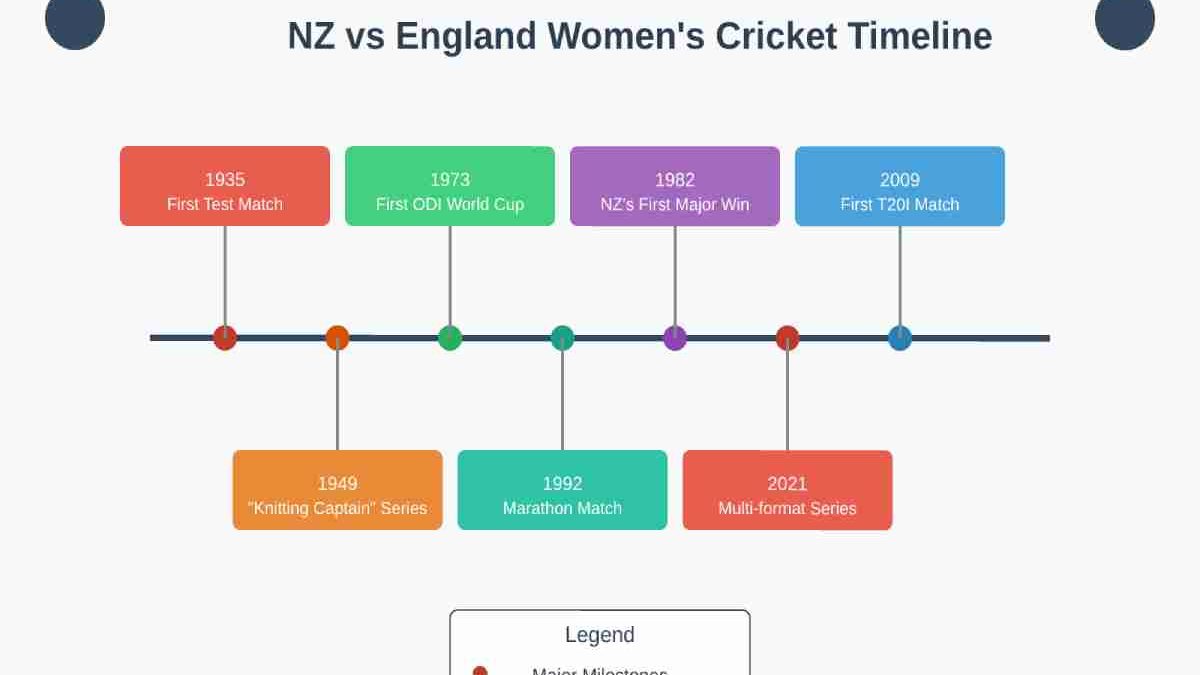New Zealand Women’s National Cricket Team vs England Women’s National Cricket Team Timeline
Table of Contents
The Pioneer Series (1935)
When New Zealand’s women first faced England, they traveled by ship in a journey that took six weeks. The players had to pay their own expenses and some even sold personal belongings to afford the trip. Betty Archdale, England’s captain, later became a prominent headmistress in Australia and was awarded an MBE for her contributions to women’s cricket.
The Knitting Captain (1949)
During the 1949 series, New Zealand captain Ruth Martin became known for knitting between overs to calm her nerves. This led to English newspapers dubbing her “The Knitting Captain,” and several English players adopted the practice in subsequent years.
The Weather Match (1966)
A unique Test match in Wellington saw all four seasons in one day – a phenomenon that led to the implementation of new weather-related playing conditions in women’s international cricket. The match included three different types of balls being used due to varying weather conditions.
The Identical Twins Incident (1984)
New Zealand fielded identical twins Rose and Ina Lamason against England, leading to confusion when both were at the crease together. The umpires eventually requested they wear different colored grips on their bats to tell them apart.
The Marathon Match (1992)
The longest women’s ODI between these teams lasted nearly nine hours due to multiple rain delays. Players from both teams ended up sharing lunch together in the pavilion, leading to a tradition of joint team lunches in subsequent series.
The Millennium Milestone (2000)
The first series of the new millennium featured a unique trophy made from a combination of native woods from both countries – Rimu from New Zealand and English Oak. The trophy is still used today for bilateral series between the teams.
The Double International Phenomenon
Both teams share a unique distinction of having players who represented their countries in multiple sports. New Zealand’s Debbie Hockley was also a national-level basketball player, while England’s Rachael Heyhoe-Flint also played field hockey internationally.
Cultural Exchange Programs
Since the 1970s, both nations have maintained a player exchange program where young cricketers spend a domestic season in the other country. Many current stars developed their skills through this initiative.
The Broadcasting First (1988)
The 1988 Test match in Christchurch became the first women’s cricket match in New Zealand to receive full television coverage, though ironically, it was interrupted by a power cut during a crucial partnership.
Innovation in Training
The rivalry led to several training innovations. New Zealand pioneered the use of male net bowlers in women’s cricket training during the 1950s, a practice England initially criticized but later adopted.
The Scholarship Legacy
Following their 1994 series, both cricket boards established a joint scholarship program for young female cricketers, named after pioneers from both countries. This program has produced several international players.
Historic Venues
The teams have played at some of cricket’s most historic venues, but also at some unusual locations. In 1957, they played a match at a ground in New Zealand that had sheep grazing on the outfield the day before the game.
Early Years (1930s-1960s)
First Encounters
The first official Test match between New Zealand and England women’s cricket teams took place in 1935. England, being the more established cricketing nation, dominated these early encounters.
Post-War Revival
After World War II, cricket relations between the two nations resumed in the 1950s, with England continuing their superiority due to their more developed domestic structure.
Modern Era (1970s-1990s)
One Day International Introduction
The advent of ODI cricket in women’s game during the 1970s brought a new dimension to this rivalry. The teams first met in ODI format during the 1973 Women’s Cricket World Cup, the first of its kind.
1982: A Turning Point
New Zealand recorded their first significant victories against England during the 1982 World Cup, showing signs of becoming a competitive force in women’s cricket.
1993 World Cup
The 1993 Women’s Cricket World Cup saw both teams produce some memorable encounters, with England generally maintaining their upper hand in crucial matches.
Contemporary Period (2000-Present)
T20 Era Begins
The introduction of T20 cricket in the mid-2000s added another format to this historic rivalry. The teams first met in T20Is during the 2009 World Twenty20.
Notable Series
2012 Series
A significant tour where New Zealand showed remarkable improvement, challenging England across all formats.
2015 Encounters
Multiple bilateral series demonstrated the growing competitiveness between the two sides, with matches becoming increasingly close.
Recent Developments (2020s)
2021 Series
England hosted New Zealand for a comprehensive multi-format series, showcasing the evolution of women’s cricket with increased media coverage and professional standards.
2023 Matches
The teams continued their rivalry with several high-profile encounters, reflecting the growing investment in women’s cricket by both nations.
Head-to-Head Statistics
Test Matches
England has historically dominated the Test format, winning the majority of their encounters.
ODI Record
A more competitive record exists in ODIs, though England maintains a slight edge in win percentage.
T20I Statistics
The shortest format has seen the closest competition between the two sides, with both teams sharing memorable victories.
Impact on Women’s Cricket
Development of the Game
This rivalry has contributed significantly to the development of women’s cricket, particularly in New Zealand where it helped raise the profile of the sport.
Future Outlook
The continuation of this historic rivalry promises to further advance women’s cricket, with both nations committed to increasing investment and professional opportunities for female cricketers.

